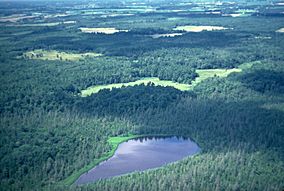Cedar Creek Ecosystem Science Reserve facts for kids
Quick facts for kids Cedar Creek Ecosystem Science Reserve |
|
|---|---|
|
IUCN Category IV (Habitat/Species Management Area)
|
|

View of Cedar Bog Lake with experimental plots in the rear
|
|
| Location | East Bethel, Minnesota, United States |
| Area | 5,600 acres (23 km2) |
| Established | 1942 |
| Governing body | College of Biological Sciences |
| Designated: | June 1975 |
The Cedar Creek Ecosystem Science Reserve is a special outdoor laboratory in East Bethel, Minnesota. It is located where the counties of Anoka and Isanti meet, just north of the big cities of Minneapolis-Saint Paul. This amazing place covers about 5,400 acres (that is about 22 square kilometers!) of different natural areas. You will find forests, prairies, swamps, and meadows here. Scientists use Cedar Creek to study how plants and animals live together and how different parts of nature connect. They have over 900 long-term experiments going on!
Contents
What is Cedar Creek?
Cedar Creek is a very important place for studying ecosystem ecology. This is the science of how living things (like plants and animals) interact with each other and their environment. The reserve has many different types of land, including:
- Upland forests
- Prairies (grassy plains)
- Lowland swamps
- Meadows
Scientists at Cedar Creek do experiments to understand things like how plants compete for resources and how different kinds of plants and animals affect each other. For example, they study herbivory, which is when animals eat plants. Many researchers from the University of Minnesota work here, including students and professors.
A Special History
The University of Minnesota started Cedar Creek in 1942. Over the years, it has received several important recognitions:
- In 1975, the National Park Service named it a National Natural Landmark. This means it is a great example of the nation's natural history.
- In 1982, the National Science Foundation made it a Long Term Ecological Research (LTER) site. This means it is part of a network of places where scientists study nature for many years.
Cedar Creek is special because it is where three major types of natural areas meet:
- Tall grass prairie
- Eastern deciduous forest (trees that lose their leaves)
- Boreal coniferous forest (evergreen trees)
This mix of habitats helps many different animals live there, including 61 types of mammals and 259 types of birds.
Birthplace of Modern Ecology
Many people think Cedar Creek is where the modern science of ecosystem ecology really began. A scientist named Raymond Lindeman did his important PhD research here. He studied Cedar Bog Lake, which is inside the reserve. His work helped connect the idea of an "ecosystem" (a term coined by Arthur Tansley) to real-world studies.
Scientists at Cedar Creek have also developed new ways to study nature:
- In the 1960s, they tested the first radio collars to track animals. This helped them learn how animals move and migrate.
- They also developed techniques for prescribed burning in savannas. This is when people carefully set small fires to help the ecosystem stay healthy.
Name Changes and Citizen Science
The reserve has had a few different names over time. It was first called the Cedar Creek Forest, named after Cedar Creek, which flows through the area. Later, it was known as the Cedar Creek Natural History Area until 2007, when it became the Cedar Creek Ecosystem Science Reserve.
Cedar Creek also has programs where regular people can help with scientific research. These are called citizen science programs. One example is a project with Zooniverse, where volunteers help scientists analyze data.



